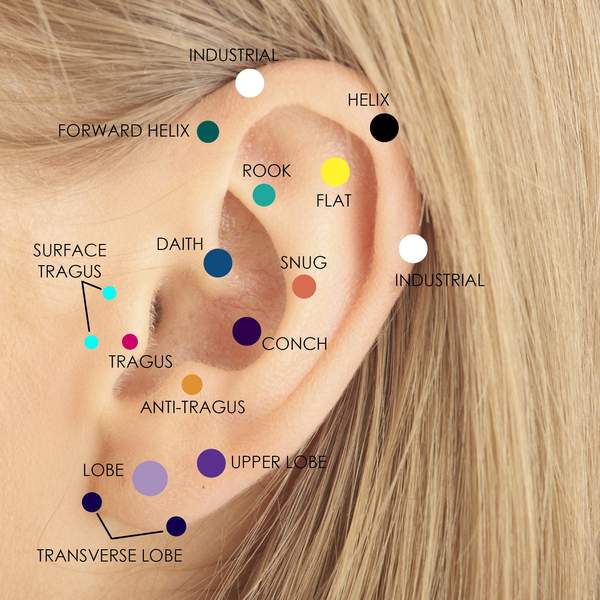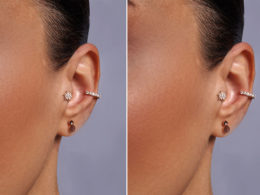Table of Contents Show
Piercings have become a means of self-expression and a beauty trend that many persons have adopted recently. It has easily made the use of rings of different types and parts of the body become a favorite way for people to accessorize their bodies.
Interestingly, there are faux rings that can be used on any preferred part of the body for persons who for reasons best known to them are unable to get real piercings. This goes to show how deeply piercings have recently been incorporated by youths as a fashion statement and as a means of representing a certain identity.
Despite the several piercings such as tragus piercing, nose piercing, tongue piercing, helix piercing, eyebrow piercing, smiley piercing, frenum piercing, belly button piercing, sternum piercing, nipple piercing, tooth piercing, wrist piercing, hip piercing, micro dermal piercing, septum piercing, back piercing, labia piercing and cheek piercing to mention a few, we will be highlighting and discussing at length, the helix piercing.
If you’re considering getting your helix pierced, this is the complete guide you need to understand everything about helix piercing. Let’s get started.
What Is A Helix Piercing?
A helix piercing which is generally known as a cartilage piercing simply refers to any piercing located on the upper cartilage of the ears.
The helix of the ear resembles a DNA type, so it was named after it. If you’re wondering whether to get a helix piercing, you would need to gather proper information on the precise location, the healing process, the choice of jewelry, and the aftercare necessary.
Types Of Helix Piercing
Helix piercings are one of the most popular piercings nowadays. It is rather simple and delicately done, and the helix has a reasonable amount of space encouraging the possibility of getting more than one piercing in that spot. For this reason, we have added the types of helix piercings you can get today;
1. Single Helix Piercing
These single helix piercings simply refer to having just one piercing done on the helix area of your ears.
2. Double helix piercings
A double helix piercing on the other hand is when there are two piercings directly located under each other in the helix area.
3. Anti-helix piercings
The anti-helix piercing which is also known as the forward piercing is located directly above the tragus. Despite being uncommon, this piercing choice is unique and the jewelry choices to customize it make it more beautiful and desirable.
4. Triple and double forward piercings
The triple and double forward piercings are merely an extension of the forward piercing. A double forward piercing would include a second piercing following the initial forward piercing while a triple piercing would include a third piercing in the same area.

How is A Helix Piercing Done?
Though some persons would want to pierce their helix at home, it is advised that one visits a professional and licensed piercer for a helix piercing. A cartilage piercing is sensitive and must be done carefully to avoid injuries or infections in the future.
To start the process, the piercer asks where you would like your piercing to be, after pointing out they would go ahead to mark the spot and ask you to confirm if it’s in the right place. After receiving a confirmation, the main process can now begin.
The piercer disinfects the tools that would be used in the process as well as the previously marked spot to lower the risks of getting an infection. Infections are a common disadvantage of piercings, so it is best to have a licensed piercer who would consciously follow through with these preventive measures to do your piercing.
After disinfecting the preferred area on the helix, the piercer will use a thin hollow needle to make a hole. Once the needle successfully passes through, your choice of jewelry will be fixed immediately. Jewelry used is usually made of titanium because it is less reactive in nature.
It is important that you do not allow them to pierce your helix with a piercing gun as it may shatter your cartilage, insist that a sterilized needle is used instead.
Following this, the one piercer will provide you with aftercare instructions to follow that would ensure the new piercing heals properly without causing unnecessary complications.
Does Having Your Helix Pierced Hurt?
A helix piercing would feel differently for different persons who undergo the process. For people with a higher pain tolerance than others, it might cause discomfort but would not sting as much as it would for persons with lower pain tolerance.
Despite this, helix piercings are on the low pain scale in comparison to other piercings since the cartilage is not as fleshy as other parts of the body, yet it is still fragile hence the sting or discomfort after getting pierced in the helix area.
Feeling discomfort after a helix piercing is normal, it’s a new opening on the ear and would not immediately feel perfectly normal. One may also experience slight bleeding, throbbing, and swelling which is a normal aftereffect of a helix piercing. However, if these symptoms are experienced in excess, you may have to revisit your piercer or a medical practitioner to determine and remedy the problem.
It is not advisable to remove the jewelry in your piercing until after the healing process is completed. Since the helix despite not being fleshy is fragile, helix piercings can lead to cartilage bumps. The healing process is particularly important and determines whether the piercing gets infected or manages to properly heal.
The pain from a helix piercing commonly lasts between two weeks to a month, depending on the individual and the exact location of the helix that was pierced. The healing process would however take longer to be completed even after the pain stops.
How Long Does It Take A Helix Piercing To Heal?
The healing time for a helix piercing is usually three to six months. These types of piercings are said to heal from the outside in, meaning that while they could look completely healed and normal on the outside, the inside might still be undergoing its healing process.
Healing patterns, experiences, and time frames would definitely vary from person to person. Some persons may heal before six months and others might take longer than that.
In some cases, persons might notice that healing is taking place but complications are being experienced as well, after visiting a medical professional they might realize that piercing in that area is particularly not healthy for them and might have to allow it close up instead.
While the piercings done on the ear lobes take a shorter time to heal, the cartilage takes longer because of the reduced blood flow in the helix as opposed to the better blood flow in the lobes.
Healing is a bearable process, especially when after-care procedures are especially being followed religiously.
How Long Do Helix Piercings Last?
Once fully healed a helix piercing becomes a permanent part of a person. However, during the three to six months healing process, if the jewelry is removed, the piercing could easily close up.
But if the helix piercing is allowed to fully undergo the healing and aftercare processes without complications, it is most likely to last for years as long as a jewelry is being placed in it regularly.
A helix piercing is one of the hardest to close up after healing is completed and changing jewelry is easier. This is because of the limited blood flow in that area, it makes healing and closing up slower so the piercing is still intact while a piece of jewelry is not in place.
What Does The Helix Piercing Aftercare Entail?
The next step after a helix piercing is finished, is being briefed by your piercer on the aftercare procedures to follow. It is important to pay attention to the aftercare routine as your health matters and these procedures are helpful in undergoing a smooth healing process as well as preventing complications or infections.
Make sure that you do not touch the piercing randomly, neither should you let other people touch it as they please, it would only endanger your health.
When the piercing comes in contact with bacteria from unwashed hands, it is prone to infections and inflammation because it is an open wound at that point.
On an occasion where contact is being made with the fresh piercing, your hands must be properly washed and sanitized first.
The liquid your piercer provides you with should be used to clean your piercing thoroughly before retiring to bed at night. This liquid is usually a saline solution or one containing tea tree oil and with a clean cotton bud, it should be applied to the helix.
The piercing should be cleaned twice a day, and even with sanitized hands avoid making too much contact with the fresh piercing to avoid causing irritations. You must also make sure to not sleep on the ear where your freshly done helix piercing is located, to avoid worsening the pain or creating a bigger wound.
What Are The Benefits Of A Helix Piercing?
A helix piercing is not just a means to symbolize an edgy and cool beauty trend. It appears to also have health benefits attached to it, we can refer to the “no pain, no gain” slogan in this case, as the pain experienced through piercing ends up offering health benefits.
These benefits are particularly attached to the forward helix piercing -arguably one of the most popularly done helix piercings- which is said by medical experts to be similar to acupuncture and auriculotherapy.
1. It is less painful
Since the helix piercing is located at the outer ear which has fewer nerves and it is thinner than other parts of the ear, the process is smoother and it is far less painful than other piercings.
2. It is medically prescribed for some ailments;
Forward helix piercings are suggested to persons who suffer from depression, migraines, and unusual increases in stress levels. For these medically advised piercings, the doctor marks out the specific pressure points on the helix where the piercings should be done. These medically done piercings are done with a numbing cream and aftercare procedures are done accordingly after the piercing.
3. It allows for easy aftercare
The helix piercing is placed at the outer ear makes the cleaning process easier than it is for piercings on other parts of the body.
4. It improves overall body health
The forward helix piercing is instrumental in relieving tense muscles, improving blood circulation, and encouraging the body to circulate the energy needed for healing. This is however only the case when the piercing is done on specific acupressure points located on the helix areas of the ears.
5. It helps relieve pain
While undergoing the process of getting a forward helix piercing done, correct application of pressure in specific pressure points that are connected to a nerve that corresponds to the area of your body where the pain is being felt will relieve the pain or discomfort previously felt.
6. It reduces skin aging signs
As earlier mentioned, the forward helix piercing increases blood circulation and muscle tone for the face and other parts of the body. This piercing helps reduce the appearance of wrinkles on the face as a means to curb early signs of skin aging.
7. It soothes the body and brain
Asides from the above-mentioned benefits, a forward helix piercing does not only soothe the body but also goes ahead to soothe the brain too. By relieving depression and stress, it reduces tension in the body and mind in a healthy manner.
What Are The Cons of Helix Piercings?
To strike a balance in the decision-making process of whether to get a helix piercing or not, the disadvantages also have to be weighed. Below are the disadvantages one might encounter after getting a helix piercing;

1. It has a longer healing period
The helix piercing takes a longer duration to heal in comparison to other body piercings. While some persons’ piercings may heal within three to six months, others might take as long as a year for their helix piercing to completely heal.
2. It may make sleeping uncomfortable at first
Sleeping on the side where your newly done helix piercing is located is not advised as it leads to complications. If you were used to sleeping on your sides before getting the piercing, sleeping may become a chore and would result in pain when you roll to your sides out of habit.
Pressing the piercing on your bed would expose it to bacteria and possible infections thereby elongating the healing process. You would have to get accustomed to sleeping on your back and changing your pillowcase and bed sheets occasionally to maintain cleanliness.
3. It does not allow one to swim in the early stages
Persons that recently have a helix piercing done are advised against swimming in any body of water, whether it be a river, pool, lake, or getting immersed in a bathtub. Being exposed to water might raise the risks of getting a bacterial infection.
It is wiser to wait until a week after getting pierced to swim and make sure to properly clean the piercing before and after you take a dip.
4. Your body may reject it.
If your helix piercing is not done properly, the chances are that your body would reject it and complications would continue until medical attention is sought and the piercing is closed. Some persons may have an allergic reaction to earrings being improperly placed or being made of irritable materials and as a result, reject the piercing.
To prevent this, it is advisable to use titanium earrings so your piercing heals without complications.
Getting pierced with a piercing gun usually causes injuries and should be avoided. It is also best to settle for an experienced and licensed piercer to avoid the body responding to the piercing negatively, it may cost more but your health matters more than saving a few bucks.
In Summary
A helix piercing is a beautiful way to accessorize one’s body. It is not as painful as other piercings and allows for more than one piercing in the same area which undoubtedly makes it an interesting and unique piercing choice.
The forward helix piercing is particularly interesting because it is medically proven to be beneficial to the health of a person is located in the right pressure points. As long as the aftercare process is paid proper attention and the healing process is smooth, a helix piercing turns out to be worth the while.
It may pose a few challenges during the slow healing process, but after healing is fully completed, it becomes a part of oneself.
Read next: Septum Piercing Guide: Pain, Healing Time, Aftercare, FAQs













